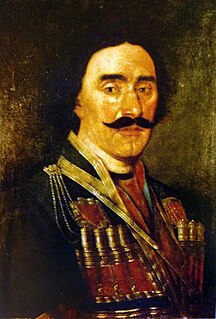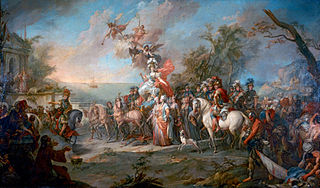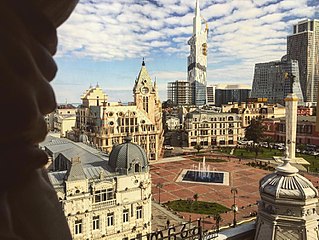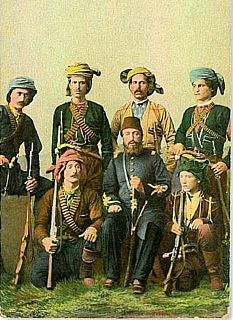Giorgi III Gurieli, of the Georgian House of Gurieli, was Prince of Guria from 1669 to 1684 and King of Imereti from 1681 to 1683. He was energetically involved in civil wars in western Georgian polities, which he sought to bring under his sway. He was killed in battle while trying to recover the lost throne of Imereti.
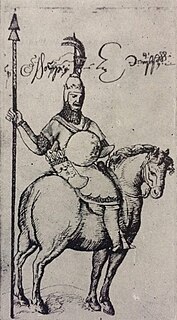
Mamia III Gurieli, also known as Mamia the Great Gurieli or the Black Gurieli, of the western Georgian House of Gurieli, was Prince of Guria from 1689 to 1714. Involved in civil wars plaguing western Georgia, he became King of Imereti three times in the years of 1701, 1711–1712, and 1713–1714. After his first reign as king for a year in 1701, he abdicated the throne of Imereti, being unable to tolerate the influence of his father-in-law Giorgi Abashidze. Subsequent periods of his royal career was the result of a feud with Giorgi VII of Imereti. Mamia died while still sitting on the throne of Imereti, which then reverted to his rival Giorgi VII.
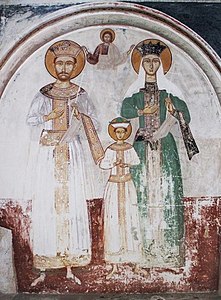
George VII, of the Bagrationi Dynasty, was King of Imereti in the periods of 1707–11, 1712–13, 1713–16, and 1719–1720.
Giorgi IV Gurieli, of the House of Gurieli, was Prince of Guria from 1711 to 1726, and a king of Imereti in western Georgia in 1716. He was installed as regent of Guria by his father, Mamia III Gurieli, then the king of Imereti, in 1712. In 1716, he seized the crown of Imereti, but was forced to abandon the enterprise later that year. Returning to Guria, his rule was challenged by a faction of local nobility, which included his mother Elene and brother Kaikhosro III Gurieli. He was finally able to crush the opposition after making peace with Bezhan Dadiani, Prince of Mingrelia.
Mamia I Dadiani was a member of the House of Dadiani and eristavi ("duke") of Odishi in western Georgia from 1323 until his death.
Mamia III Dadiani was a member of the House of Dadiani and eristavi ("duke") of Odishi, that is, Mingrelia, in western Georgia from 1512 until his death. Mamia was a son and successor of Liparit II Dadiani, who had emerged as a semi-independent ruler in the process of dissolution of the Kingdom of Georgia. Mamia was culturally active in Abkhazia and continued his predecessors' efforts to secure borders against the North Caucasian mountainous tribes of Zygia. His naval expedition against them and landing in Zygia ended in a fiasco and Mamia was killed in battle.
Giorgi III Dadiani was Prince of Mingrelia, of the House of Dadiani, from 1572 to 1573 and again from 1578 until his death. He was a son and successor of Levan I Dadiani.
Mamia IV Dadiani was Prince of Mingrelia, of the House of Dadiani, from 1573 to 1578 and again from 1582 until his death. He was a younger son of Levan I Dadiani.
Mamia I Gurieli, of the House of Gurieli, was Prince of Guria from 1512 until his death in 1534. Succeeding on the death of his father Giorgi I Gurieli, Mamia became involved in the conflict between the two eastern Georgian kingdoms of Kartli and Kakheti in 1520; by force of arms, he compelled David X of Kartli to agree on peace with Levan of Kakheti, his son-in-law. Mamia Gurieli's 1533 campaign, jointly with his namesake Prince of Mingrelia, against the homebase of Circassian pirates ended in a fiasco, with Mamia being captured and ransomed later that year.
Rostom Gurieli, of the House of Gurieli, was Prince of Guria from 1534 until his death in 1564. Alongside his royal suzerain, Bagrat III of Imereti, Rostom fought against the expanding Ottoman Empire to which he lost parts of his principality. Rostom's relations with Bagrat III subsequently deteriorated over his support to the king's defiant vassal, Levan I Dadiani.
Giorgi II Gurieli, of the House of Gurieli, was Prince of Guria from 1564 to 1583 and again from 1587 to 1600. Succeeding on the death of his father Rostom Gurieli, Giorgi's rule over his small principality, located in southwest Georgia, was a period of conflict with the neighboring Dadiani of Mingrelia and increasing assertiveness of the Ottomans whom Gurieli submitted in 1581. His reign was interrupted, from 1583 to 1587, by a Mingrelian invasion, but Giorgi was able to resume the throne with Ottoman support.
Vakhtang I Gurieli, of the House of Gurieli, was Prince of Guria from 1583 to 1587. He ruled Guria, a small state in southwestern Georgia, as a client of Mamia IV Dadiani, Prince of Mingrelia, who had deposed Giorgi II Gurieli. Vakhtang was one of the sponsors of the Shemokmedi Monastery, Guria's principal cathedral.
Mamia II Gurieli, of the House of Gurieli, was Prince of Guria from 1600 until his death at the hands of his own son Simon in 1625. Mamia's rule over his small principality, located in southwest Georgia, saw efforts to rebuff encroachments of the Ottoman Empire, with which he was forced to make peace in 1614, conceding the loss of territories and placing Guria under the obligation of paying tribute.
Kaikhosro I Gurieli, of the House of Gurieli, was Prince of Guria from 1626 to 1658. He was installed by Levan II Dadiani, Prince of Mingrelia, in place of his deposed predecessor Simon I Gurieli. In his turn, Kaikhosro was overthrown and expelled by King Alexander III of Imereti. His comeback to Guria, in an Ottoman-supported endeavor, concluded with his assassination by a Gurian nobleman.
Malakia Gurieli, of the Georgian House of Gurieli, was Prince of Guria from 1684 to 1685 and again in 1689. A younger son of Kaikhosro I Gurieli, he succeeded on the death of his brother Giorgi III Gurieli in 1684, only to be overthrown and blinded by his nephew Kaikhosro II Gurieli. Briefly restored through the Ottoman intervention in 1689, he was deposed by Guria's nobility for incompetence. Malakia entered the priesthood and became Bishop of Shemokmedi.
Kaikhosro II Gurieli, of the House of Gurieli, was Prince of Guria, in western Georgia, from 1685 to 1689. He vied for the control of Guria with his uncle, Malakia Gurieli, who he had blinded. Kaikhosro was eventually killed by agents of the Ottoman pasha of Akhaltsikhe, who sought regional hegemony in southwestern Caucasus.
Simon II Gurieli, of the western Georgian House of Gurieli, was Prince of Guria from 1788/89 to 1792.
Vakhtang II Gurieli, of the House of Gurieli, was Prince of Guria, in western Georgia, from 1792 to 1797. He succeeded on the death of his elder brother Simon II Gurieli and was deposed by a younger brother Kaikhosro. Vakhtang's subsequent efforts to regain power were futile.



